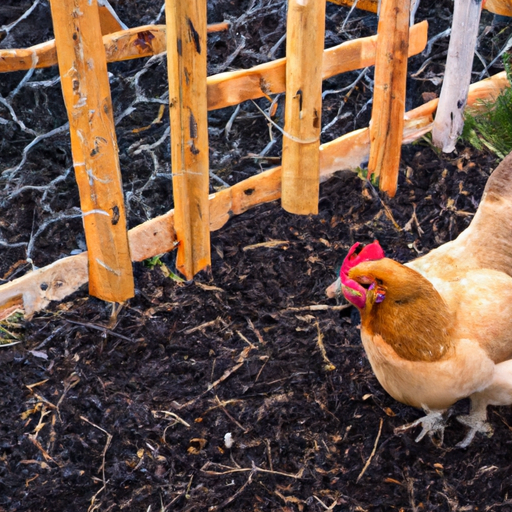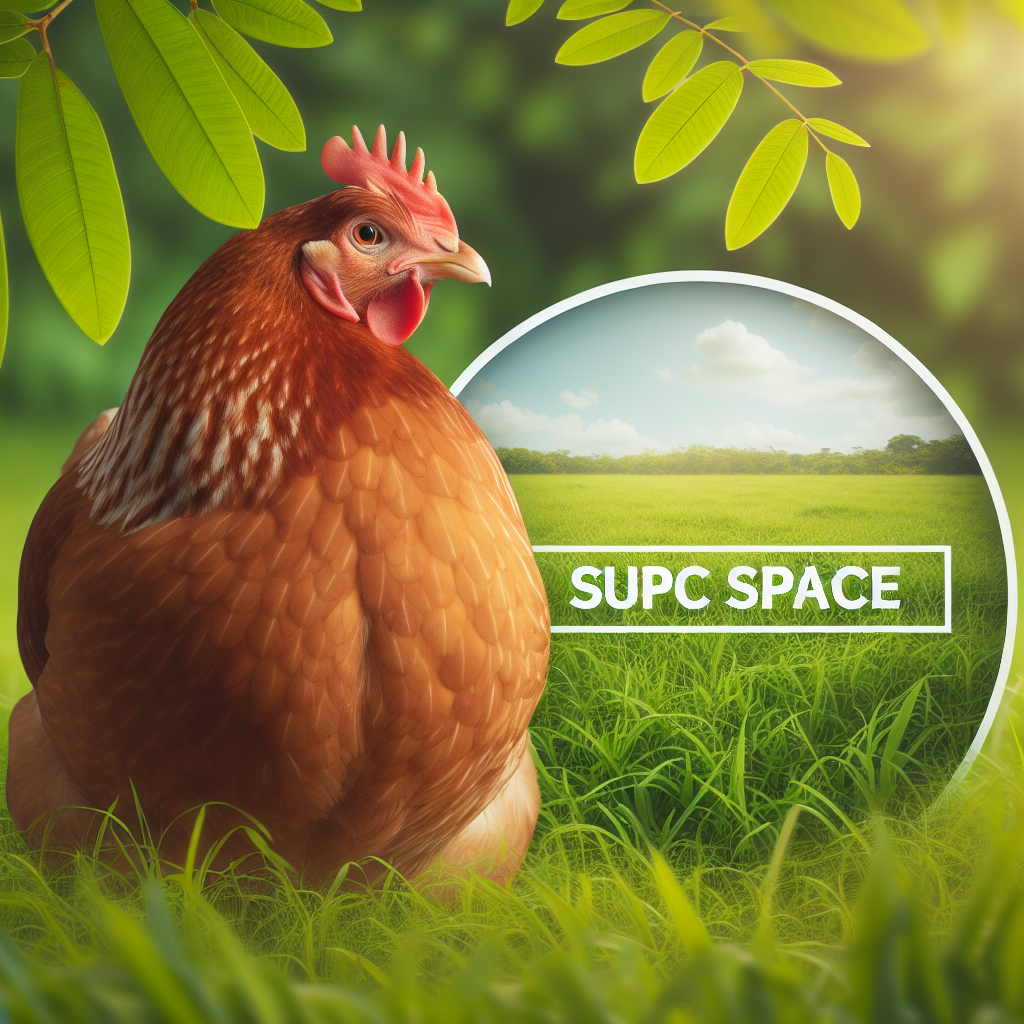If you’re a chicken owner who wants to provide your feathered friends with plenty of space to roam and explore, you may be wondering how to ensure they have enough room for their free-ranging activities. Ensuring adequate space for your chickens is not only important for their well-being and happiness, but it can also contribute to their overall health and productivity. In this article, we’ll explore some practical tips and considerations to help you create a suitable environment that allows your chickens to fully enjoy their free-range time. So, let’s dive in and discover how you can give your chickens the space they need to thrive!
Choosing the Right Size of Space
Evaluating the Number of Chickens
Before you start designing your chicken run, it’s essential to evaluate the number of chickens you have. The number of birds will determine the overall size of the space needed to accommodate them comfortably. As a general rule of thumb, you should allow for a minimum of 4 square feet per chicken in the chicken run area. This calculation takes into account the amount of space they need to move around, spread their wings, and engage in natural behaviors.
Providing Sufficient Space per Chicken
To ensure your chickens have adequate space for free-ranging activities, it’s crucial to provide enough square footage per bird. Providing them with enough space will not only promote their physical and mental well-being but also help prevent stress and aggression among the flock. It’s always better to err on the side of caution and provide more space rather than less.
Considering the Breed and Size of Chickens
The breed and size of your chickens should also be factored in when determining the size of the space they need. Larger breeds may require additional space to maneuver comfortably, while smaller breeds may be content with slightly less square footage. Research the specific breed or breeds of chickens you have to better understand their needs and make appropriate adjustments to your space requirements.
Designing the Chicken Run
Determining the Shape and Layout of the Run
When designing your chicken run, consider the shape and layout that will work best for your space and the number of chickens you have. A rectangular or square shape is often practical, as it maximizes the available space and makes it easier to install safety features and accessories. Sketch out your desired layout, taking into account any existing structures or natural features in your backyard that could impact the design.
Creating Safe Boundaries
One of the primary objectives when designing a chicken run is creating safe boundaries to keep your chickens secure. To prevent escape and protect your birds from predators, it’s essential to have fencing or walls that are at least 6 feet in height and buried at least 12 inches below ground. This will deter predators from digging under the enclosure.
Including Necessary Features
A well-designed chicken run includes various features that enhance the chickens’ overall well-being. These features include perches, dust bathing areas, foraging spaces, and hiding spots. Perches or roosting bars should be installed at different heights to accommodate each chicken comfortably. Dust bathing areas can be created by providing a designated space with loose dirt or sand for your chickens to roll and clean themselves. Additionally, consider adding vegetation or natural cover elements to create hiding spots and mimic their natural environment.
Creating a Free-Range Schedule
Balancing Free-Range Time and Confinement
Balancing the amount of time your chickens spend in free-range activities versus confinement is vital for their health and safety. While free-ranging allows them to engage in natural behaviors, confining them for too long can lead to stress and other behavioral issues. It’s recommended to provide at least a few hours of free-range time each day while ensuring that they have a secure and comfortable coop area to return to when needed.
Optimizing Free-Range Time Based on Breed
Different chicken breeds have varying levels of activity and foraging needs. Some breeds may be more content spending longer hours confined, while others thrive on ample free-range activities. Research the specific breed(s) you have to understand their natural behaviors, energy levels, and foraging tendencies. This will help you optimize their free-range time accordingly, whether it’s by allowing them more time outdoors or providing additional enrichment activities within the chicken run.
Considering Predators and Other Safety Concerns
When establishing a free-range schedule, it’s crucial to consider potential predators and other safety concerns in your area. Depending on your location, predators such as raccoons, foxes, or hawks may pose a threat to your chickens. Plan their free-range time accordingly, ensuring they are supervised during periods of high predator activity or providing secure shelters and hiding places within the chicken run.
Managing the Chicken Coop
Providing Adequate Space Inside the Coop
While chickens need ample outdoor space for free-ranging activities, it’s equally important to provide them with adequate space inside the coop. The coop serves as their shelter during the night and protects them from adverse weather conditions, predators, and disease transmission. Allow for a minimum of 4 square feet per chicken inside the coop, ensuring they have ample room to comfortably roost and move around.
Including Roosting Bars and Nesting Boxes
To create a comfortable and functional coop, include roosting bars and nesting boxes for your chickens. Roosting bars should be placed at varying heights to accommodate chickens’ preferences, and each bird should have at least 8 inches of roosting space. Nesting boxes should be easily accessible and provide a quiet and dark space for hens to lay their eggs comfortably.
Ensuring Proper Ventilation and Lighting
Proper ventilation and lighting are essential for maintaining a healthy coop environment. Ventilation allows for fresh air exchange, prevents the buildup of harmful gases, and helps regulate temperature and humidity levels. Install windows or vents that can be opened or closed as needed. Adequate lighting is also crucial and promotes egg production. Natural light is ideal, but you may need to supplement with artificial lighting during shorter daylight periods.
Implementing Good Land Management Practices
Rotating Grazing Areas
Rotating grazing areas is an effective practice that allows the vegetation to regenerate and prevents overgrazing. This not only ensures a fresh food source for your chickens but also helps maintain a healthy and diverse ecosystem. Divide your available space into multiple areas and rotate your chickens between them periodically, giving each area time to recover.
Maintaining Organic Vegetation
Incorporating organic vegetation into your chicken run provides a range of benefits. It offers additional foraging opportunities for your chickens, enriches their diet with natural greens, and contributes to their overall well-being. Ensure the vegetation is safe and non-toxic for your chickens, and regularly replenish or replace it as needed.
Avoiding Overcrowding and Overgrazing
Overcrowding and overgrazing can lead to numerous issues, including soil degradation, nutrient deficiencies, and increased risk of disease transmission. To prevent these problems, avoid overcrowding your chicken run and provide sufficient space for your chickens to roam and forage. Monitor the vegetation regularly and take action to prevent overgrazing, such as rotating grazing areas or providing supplemental feed when necessary.
Following Biosecurity Measures
Limiting Access of Outside Animals
To minimize the risk of disease transmission, it’s crucial to limit the access of outside animals to your chicken run and coop. Wild birds, rodents, and other animals can carry diseases and parasites that can harm your flock. Ensure that your fencing is secure and regularly inspect it to identify and repair any potential entry points. Additionally, keep your chickens’ feed and water areas clean and protected from outside animals.
Quarantining New Birds
When introducing new birds to your existing flock, it’s essential to quarantine them for a period of time. This quarantine period allows you to observe the newcomers for signs of illness or disease and prevent potential transmission to your established flock. Keep the new birds in a separate area, ideally with a separate coop and run, before gradually integrating them with the rest of the flock.
Implementing Sanitary Practices
Maintaining proper hygiene and sanitation practices is key to preventing the spread of diseases and ensuring the health of your chickens. Regularly clean and disinfect the coop and run, including nesting boxes, roosting bars, and food and water containers. Dispose of manure and soiled bedding properly, following local regulations and guidelines. Good sanitation practices will help minimize the risk of parasites, bacteria, and other pathogens affecting your flock.
Monitoring and Addressing Behavioral Issues
Identifying Signs of Stress or Aggression
Regularly monitor your chickens’ behavior to identify any signs of stress or aggression. Signs of stress can include excessive feather pecking, feather loss, vocalizations, or decreased egg production. Aggression can manifest as aggressive pecking, chasing, or territorial behaviors. If you notice any concerning behaviors, investigate the underlying causes and take appropriate action to address them.
Promoting Healthy Social Interactions
Encouraging healthy social interactions among your chickens is important for their overall well-being. Ensure that there is enough space and resources for all birds to minimize competition and aggression. Providing multiple food and water sources, as well as providing enrichment activities, such as hanging treats or installing perches at different heights, can help promote positive social interactions and reduce stress.
Providing Enrichment Activities
Enrichment activities are essential for keeping your chickens mentally stimulated and engaged. Boredom can lead to the development of destructive behaviors or aggression within the flock. Provide your chickens with a variety of enrichment activities, such as hanging vegetables or treats, scattering food for them to forage, or providing them with dust bathing areas. These activities mimic natural behaviors and help keep your chickens happy and healthy.
Adjusting Space Based on Chickens’ Development
Managing Space for Chicks and Juveniles
Chicks and juvenile chickens have different space requirements than adult birds. When raising young chickens, it’s important to provide a smaller, more secure area or brooder initially. As they grow, gradually introduce them to larger spaces, ensuring they have enough space to move around comfortably. Monitor their behavior and make adjustments as needed to accommodate their changing needs.
Adapting Space for Maturing Adult Chickens
As your chickens mature into adulthood, they will require more space to accommodate their increasing size and energy levels. Consider expanding the chicken run or providing additional alternative spaces for free-ranging activities. Pay attention to their behavior, and if you notice any signs of overcrowding or stress, make necessary adjustments to ensure their well-being.
Modifying Space for Aging or Special Needs Chickens
Just like humans, chickens have different needs as they age or if they have special requirements. Older chickens or those with physical limitations may need easier access to perches or nesting areas. Observe how your aging or special needs chickens move and interact with their environment, and make any necessary modifications to ensure their comfort and safety.
Considering Local Climate and Weather Factors
Providing Shelter from Extreme Temperatures
Extreme temperatures can be harmful to chickens, so it’s crucial to provide them with appropriate shelter. In hot climates, ensure that the chicken run has shaded areas to protect them from the scorching sun. You can use natural shade from trees or create artificial shade with structures like pergolas or tarps. In cold climates, insulate the coop and ensure it is draft-free to keep your chickens warm.
Offering Shade and Dust Bathing Areas
Chickens need access to shade for protection from direct sunlight and to cool down during hot weather. Providing shade within the chicken run allows them to regulate their body temperature comfortably. Additionally, create designated dust bathing areas with loose dirt or sand. Dust bathing is a natural behavior that helps chickens keep their feathers clean and control parasites.
Addressing Wet or Snowy Conditions
Wet or snowy conditions can pose challenges for your chickens, so it’s important to take appropriate measures to address these weather conditions. Ensure that the coop and run are well-drained to prevent flooding or excessive moisture buildup. Install gutters or rain diverters to minimize water runoff into the chicken run. In snowy areas, consider providing sheltered areas or using bedding materials that provide insulation and protection from the cold.
Seeking Professional Advice
Consulting Local Agriculture Extension or Poultry Experts
If you’re new to raising chickens or facing specific challenges, consulting local agriculture extension services or poultry experts can provide valuable guidance. These professionals are knowledgeable about local conditions and can offer advice tailored to your specific needs. They can provide recommendations on space requirements, coop design, breed suitability, and many other aspects of chicken care.
Attending Workshops or Training Sessions
Attending workshops or training sessions related to chicken care and management can be incredibly beneficial, especially for beginners. Workshops often cover a wide range of topics, from basic chicken care to more advanced techniques. It allows you to learn from experienced poultry enthusiasts, ask questions, and gain practical knowledge that you can apply to your own chicken-raising endeavors.
Joining Poultry Enthusiast Communities
Joining poultry enthusiast communities, both online and offline, can connect you with like-minded individuals who share a passion for raising chickens. These communities are an excellent resource for getting advice, exchanging ideas, and learning from the experiences of others. By joining these communities, you can tap into a wealth of knowledge and build a support network of fellow chicken enthusiasts.
By considering these factors and implementing best practices, you can ensure that your chickens have adequate space for free-ranging activities and create a safe and stimulating environment for them to thrive. Remember, happy and healthy chickens make for happy chicken keepers!




